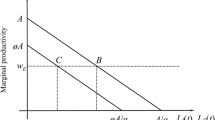Abstract
In this paper the relevance of the insider-outsider theory is investigated for the Netherlands. Estimation results of a macro wage equation show that the insider-outsider distinction has some empirical relevance, because the lay-off rate has a significant negative influence on wages. However, the extreme insider-outsider model is rejected, because wages are also found to be significantly negatively related to the rate of long-term unemployment.
Similar content being viewed by others
References
Blanchard OJ, Summers LH (1986) Hysteresis and the European Unemployment Problem. In: Fischer S (ed) NBER Macroeconomic Annual, vol 1, September. MIT Press, Cambridge pp 15–78
Blanchard OJ, Summers LH (1987) Hysteresis in Unemployment. European Economic Review 31, pp 288–295
Blanchflower DG, Oswald AJ, Garrett MD (1989) Insider power in wage determination. NBER Working Paper No 3179
Budd AP, Levine P, Smith PN (1987) Real Wage Adjustment and Long Term Unemployment. In: Cross RB (ed) Unemployment, Hysteresis and the Natural Rate Hypothesis. Oxford, Blackwell, pp 41–64
Calmfors L, Driffill J (1988) Centralisation of Wage Bargaining. Economic Policy, April, pp 13–61
Carruth AA, Oswald AJ (1987) On Union Preferences and Labor Market Models, Insiders and Outsiders. The Economic Journal 97, pp 431–445
Christofides LN, Oswald AJ (1989) Real Wage Determination in Collective Bargaining Agreements. NBER Working Paper No 3188
Crafts NFR (1989) Long-Term Unemployment and the Wage Equation in Britain, 1925–1939. Economica 56, pp 247–254
Davidson JEH, Hendry DF, Srba F, Yeo S (1978) Econometric Modelling of the Aggregate Time Series Relationship Between Consumers, Expenditure and Income in the United Kingdom. Economic Journal 88, pp 661–692
Engle RF, Granger CWJ (1987) Co-Integration and Error-Correction: Representation, Estimation and Testing. Econometrica 55, pp 251–276
Flanagan RJ (1988) Unemployment as a Hiring Problem. OECD Economic Studies, No 11, pp 123–154
Graafland JJ (1988) Hysteresis in Unemployment in the Netherlands. De Economist 136, pp 508–523
Graafland JJ (1989) Can Hysteresis Explain Different Labour Market Operations Between Europe and the United States? Applied Economics 21, pp 95–111
Graafland JJ (1991) On the Causes of Hysteresis in Long-Term Unemployment in the Netherlands. Oxford Bulletin of Economics and Statistics 53, pp 155–170
Hall SG (1986) An Application of the Granger and Engle Two-Steps Estimation Procedure to United Kingdom Aggregate Wage Data. Oxford Bulletin of Economics and Statistics 48, pp 229–239
Hoel M, Nymoen R (1988) Wage Formation in Norwegian Manufacturing: An Empirical Application of a Theoretical Bargaining Model. European Economic Review 32, pp 977–997
Huizinga FH, Schiantarelli F (1988) Insiders-Outsiders and Membership Rules: The Effects of Employment and Wage Bargaining. Mimeo, Boston University
Layard PRG, Nickell SJ (1986) Unemployment in Britain. Economica 53, pp s121-s169
Layard PRG, Bean C (1989) Why Does Unemployment Persist? Scandinavian Journal of Economics, No 2, pp 371–396
Lindbeck A, Snower DJ (1986) Wage Setting, Unemployment and Insider-Outsider Relations. The American Economic Review. Papers and Proceedings 76, pp 235–239
Lindbeck A, Snower DJ (1987a) Union Activity, Unemployment Persistence and Wage-Employment Ratchets. European Economic Review 31, pp 157–167
Lindbeck A, Snower DJ (1987b) Efficiency Wages versus Insiders and Outsiders. European Economic Review 31, pp 407–416
Lindbeck A, Snower DJ (1988) Cooperation, Harassment and Involuntary Unemployment: An Insider-Outsider Approach. The American Economic Review, pp 167–188
Mulder CB (1990) Langdurige Werkloosheid in Nederland. Economisch Statistische Berichten, pp 132–136
Nickell SJ, Andrews M (1983) Unions, Real Wages and Employment in Britain 1951–1979. Oxford Economic Papers, pp 183–206
Nickell SJ (1987) Why is Wage Inflation in Britain so High? Oxford Bulletin of Economics and Statistics 49, pp 103–128
Rompuy van P, Bruyne de G, Voorde van de C (1988) Taxation, Wages and Employment in a Unionized Economy. Tijdschrift voor Economie en Management, vol XXXIII, No 3–4, pp 261–270
Sargan JD (1964) Wages and Prices in the United Kingdom: A Study in Econometric Methodology, Reprinted in Hendry D, Wallis K (eds) Econometrics and Quantitative Economics. Oxford, Basil Blackwell, pp 275–314
Solow RM (1985) Insiders and Outsiders in Wage Determination. Scandinavian Journal of Economics 87, pp 411–428
Author information
Authors and Affiliations
Rights and permissions
About this article
Cite this article
Graafland, J.J. Insiders and outsiders in wage formation: The dutch case. Empirical Economics 17, 583–602 (1992). https://doi.org/10.1007/BF01205397
Received:
Revised:
Issue Date:
DOI: https://doi.org/10.1007/BF01205397




